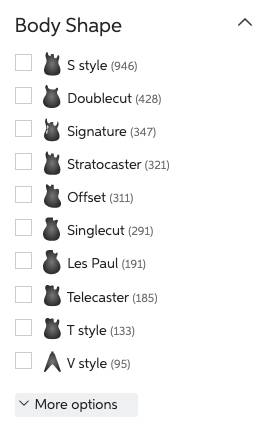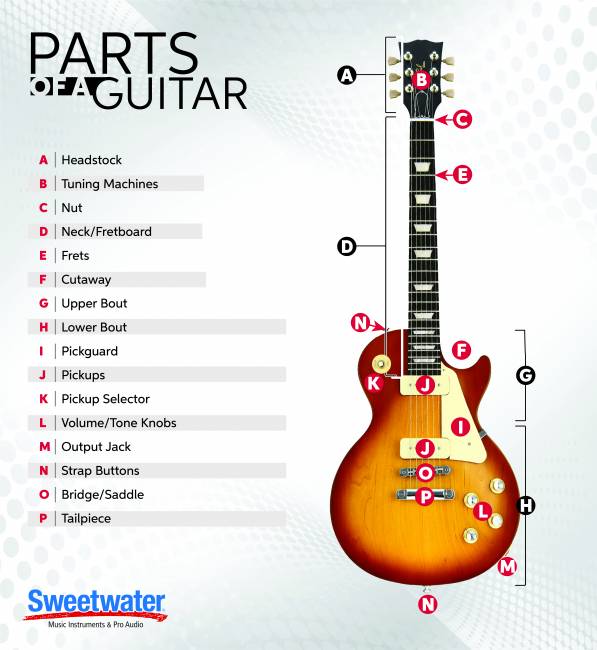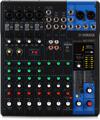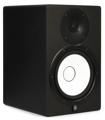
Despite what some folks claim, the electric guitar is more popular than ever. Don’t believe us? As of summer 2023, there are 3.7 million #electricguitar posts on Instagram. And the bulk of them were created by millennials and Zoomers, not aging dinosaur rockers. In short, the electric guitar is alive, it’s vibrant, and it’s continuously evolving. It’s an exciting time to pick up the instrument, too, as today’s entry-level electric guitars offer a level of quality that far surpasses the low-end axes of decades past.
In this article, Sweetwater delves into our favorite electric guitars for beginners. We recommend these models to our customers, and we’re confident that once you find the right one and start playing it, you’ll never want to stop. Plus, if you’re buying your first electric guitar, then this article includes a helpful Electric Guitars Buying Guide for Beginners to assist you in finding the guitar of your dreams!
Note: At Sweetwater, we know there’s no such thing as “best” when it comes to music gear. Every player and artist has unique tastes, which is what makes selecting gear so fun! The items on this list feature some of our favorite products from top manufacturers to help you start your buying journey! Explore these recommendations and dive into Sweetwater’s massive collection of gear on our online store. For personalized picks and expert advice, please contact our knowledgeable Sweetwater Sales Engineers at (800) 222-4700!
- Yamaha Pacifica Series
- Epiphone One Collection
- Epiphone Modern Collection
- Epiphone Power Players Series
- Squier Classic Vibe Series
- Squier Paranormal Series
- Squier Sonic Series
- Gretsch Streamliner Collection
- Jackson JS
- Ibanez GIO
- Ibanez Standard
- ESP LTD
- Kramer Original Collection
- Sterling by Music Man Cutlass
Best Electric Guitars for Beginners — Our Picks
Yamaha Pacifica Series
If you’re hunting for a high-quality, entry-level electric guitar, then a Yamaha Pacifica should definitely be on your radar. These double-cut axes offer performances that belly their modest price tags. Pacificas have been around since the early 1990s, providing novice and professional players alike with outstanding, roadworthy instruments. They feature contoured bodies, sleek neck profiles, and fast-playing fretboards. Plus, they’re available in a variety of pickup configurations.
Epiphone One Collection
The Epiphone One Collection offers value-packed electric guitars for beginners. This series features solidbody guitars descended from Gibson’s most iconic models: the Les Paul and the SG. The Epiphone Les Paul is an enduring favorite among rock and jazz players, while the aggressive bite of the Epiphone SG makes it perfect for classic rock, punk, and everything in between. This collection of guitars has something for everyone! All the guitars are made from highly resonant tonewoods and loaded with premium electronics. First up from Epiphone is the Les Paul Studio E1 electric guitar, which features a carved mahogany body, a set neck, and two alnico humbuckers. Next, from its stripped-back look to its strong tone, Epiphone’s SG Special Satin E1 electric guitar is all business. Epiphone’s Les Paul Melody Maker E1 is one of the more affordable electric guitars in the line, perfect for those wishing to dip their tones into this collection without emptying their pocketbooks.
Epiphone Modern Collection
The Epiphone Modern Collection ups the ante on affordable Epiphone designs. Several body shapes and trim levels with various upgrades are offered, including new tonewoods, exotic finishes, and upgraded electronics. Some models, like the Prophecy guitars, include modern-sounding, multi-voice Fishman Fluence humbuckers and redesigned neck heels for easy access to the upper frets. Other Epiphone models, like the SG Classic Worn, feature Epiphone P-90 PRO single-coil pickups that give guitarists that classic midrange bite. Finally, the Modern series features Epiphone ProBuckers and ebony fingerboards for a vintage sound with contemporary playability. Although slightly more expensive than the Epiphone One Collection, Epiphone’s Modern Collection is full of electric guitars for beginners looking for rock-solid instruments to last them years.
Epiphone Power Players Series
Designed with scaled-down body sizes and shorter scale lengths, guitars in the Epiphone Power Players series are tailor-made for children who want to play guitar. This line offers the classic SG and Les Paul guitar shapes at about three-quarters of the size of the original designs, ensuring effortless playability while maintaining the spirit of those iconic designs. Whether you choose a Les Paul or an SG, the guitar comes equipped with Epiphone-designed humbucking pickups for great, plugged-in tone. Plus, every Power Players guitar comes with a gig bag, a guitar strap, some guitar picks, and a guitar cable — all at an amazingly low price. The Epiphone Power Players series is the ideal starting point for younger guitar players with small hands.
Squier Classic Vibe Series
Beginners with a hankering for classic Fender designs should head straight for the Squier Classic Vibe series. These instruments are among the best values in the electric guitar world, combining vintage-inspired tone and aesthetics with unbelievable, budget-friendly prices. Thanks to Squier’s Classic Vibe instruments, neophyte musicians can get their mitts on period-accurate re-creations of ’50s-, ’60s-, and ’70s-era Stratocasters, Telecasters, Jaguars — and more — with modern touches, such as easy-playing, C-shaped necks and 9-1/2-inch-radius fretboards. Intermediate and even some pro players have been known to snatch up Classic Vibes. They make excellent modding platforms, too!
Squier Paranormal Series
Perfect for players looking to pave their own way, the Squier Paranormal series offers an array of idiosyncratic guitars and basses that will inspire! In essence, the Paranormal series is Squier’s playground for experimentation, mixing and matching various elements from the Squier/Fender playbook to create wholly unique models that will set you apart from the pack. 12-string Jazzmasters? Sure! Dual-humbucker offset basses? Why not? Soapbar-loaded baritone Telecasters? Absolutely. The Squier Paranormal series offers some of the best electric guitars for beginners who want something different from the same old 6-strings that everyone else starts with. Finally (and best of all), instruments from Squier’s Paranormal series are so sonically and aesthetically distinctive that they’re guaranteed to remain relevant tools long past the beginner stage — plenty of Sweetwater musicians keep one or two around as their “secret studio weapon” or simply as a rock-solid performing instrument.
Squier Sonic Series
Guitars in the Squier Sonic series are the most affordable Fender-style instruments in the company’s stable. This line picks up where the Squier Bullet Series left off, making high-demand models and finishes available to first-time guitarists. Sonic Stratocasters come in both SSS and HSS pickup configurations. Short-scale Sonic Mustangs — available in modern HH and true classic SS configurations — are ideal for young players with small hands. And Tele lovers: Squier didn’t forget about you. The Sonic series includes standard Sonic Telecasters and a handful of single-humbucker Sonic Esquires. All Squier Sonic guitars include quality electronics that elicit Fender’s characteristic tone, along with comfortable necks and tuning-stable bridges.
Gretsch Streamliner Collection
Built for players and priced for beginners, the Gretsch Streamliner collection is chock-full of excellent entry-level electric guitars. Three general body styles are available: resonant and sleek solidbody guitars, center-block models with a feedback-fighting semi-hollowbody design, and hollowbody styles. As for pickups, two options are available. Numerous models have humbucking pickups for quiet operation and thick tone. A smaller subset of Streamliner models comes loaded with P-90 single-coil pickups for rip-roaring sound. Finally, you get two tailpiece options: a Bigsby that adds expressive vibrato or Gretsch’s iconic V-shaped stop tailpiece for increased tuning stability. If you’re a beginner looking for an electric guitar with unique, vintage-style tones and unforgettable good looks, then you’ll want a Gretsch Streamliner.
Jackson JS Series
Burgeoning shredders — especially metal-minded ones — need high-performance instruments. And the pointier the headstock, the better. If this describes you, then get your hands on a Jackson JS Series electric guitar. As one of the most cost-effective entryways into the world of shred-approved instruments, JS guitars bear all the hallmarks of the genre: slender graphite-reinforced necks, lightning-fast compound-radius fretboards, and high-octane, high-output pickups. Many of Jackson’s classic designs — such as the Dinky and King V — are represented in a variety of eye-popping finishes, complete with the company’s trademark shark fin fingerboard inlays. Purchasing from the JS Series is also one of the least expensive ways to acquire an axe with a real-deal double-locking tremolo.
Ibanez Gio Collection
Ibanez has long been a top brand of choice for shredding virtuosos, and the Ibanez Gio collection was designed especially for nascent shredders. These budget-priced guitars have all the right components for high-speed fretboard pyrotechnics: thin necks, contoured bodies, high-output humbuckers, and spotlight-stealing finishes. Several Gio instruments are based on standard Ibanez models. For example, Gio GRG guitars are derived from Ibanez’s iconic RG series. The Gio collection offers an affordable way for new players to experience Ibanez for the first time.
Ibanez Standard Series
Forward-thinking designs and unique sounds make the Ibanez Standard series stand out. Ibanez cuts no corners during construction to ensure that all Standards are the perfect electric guitars for beginners. And since this line includes many different body shapes, players can choose an electric guitar that suits their visual and sonic desires. You’ll enjoy wickedly thin necks, effortless playability, comfortable body shapes, and excellent pickups on every model. Whether you’re looking for an aggressive metal machine, a straight-ahead rocker, or an axe for the blues, the Ibanez Standard series has all of those — and so much more.
ESP LTD Series
The ESP LTD series was originally intended to give beginning players and working musicians access to metal-approved electric guitars. That said, the line varies wildly between entry-level rockers and feature-laden, professional-quality instruments. LTD guitars offer serious bang for your buck — even models priced at $500 and under include high-end features like figured tops, premium tonewoods, multipiece necks, rock-solid hardware, and excellent-sounding pickups in a myriad of configurations. These “made for metal” electric guitars come in several aggressive-looking body shapes — like the EC, Arrow, and Viper — and provide up-and-coming, hard-rock guitarists with a great platform for honing their craft.
Kramer Original Collection
Harkening back to the golden days of hair metal, the Kramer Original Collection contains the perfect electric guitars for beginners interested in high-gain heroics. The Kramer Focus VT-211S electric guitar offers a familiar S-style body shape with HSS-configured pickups and a tremolo bridge. Don’t need that much tonal versatility? Kramer’s Baretta Special electric guitar has a single humbucker and master volume knob that will serve you well. And if you’ve always wanted to dive-bomb with the best of them, then the Floyd Rose double-locking tremolo bridge on Kramer’s Striker HSS electric guitar is the way to go. Every axe in the Original Collection also includes a colored headstock that stands out from the crowd. Whichever axe you choose, you’ll enjoy the eye-popping finish and tonal tenacity.
Sterling by Music Man Cutlass Collection
The Cutlass is a groovy take on the beloved S-style guitar. Every guitar from the Sterling by Music Man Cutlass collection leverages high-tech construction methods and unwavering attention to detail to provide first-time players with finely tuned, modestly priced guitars. For new guitar students, we recommend the Cutlass CT30, of which two varieties are available. The Cutlass CT30SSS electric guitar features a trio of single-coil pickups for classic tones with plenty of flexibility. Meanwhile, the Cutlass CT30HSS electric guitar offers two sparkling single-coil pickups and a full-throated humbucking pickup in the bridge. Players looking for higher performance quality can step up to the Cutlass CT50SSS electric guitar with its climate-stable, roasted maple neck and its vintage tremolo. Every Cutlass comes with a 5-way pickup selector switch, streamlined controls, and super-comfortable body contours.
Electric Guitar Buying Guide for Beginners
So, you’ve decided to buy your first electric guitar! Congratulations! You’re embarking on an endlessly satisfying journey filled with music, fun, and creativity. As you’re shopping for your first guitar, you might be asking yourself, “Where do I even begin?” We hear you. Guitar players at Sweetwater have been in your exact position: overwhelmed by the many available options. That’s why we’ve created this ultimate electric guitar buying guide for beginners. We will walk you step-by-step through all the things you should consider when choosing your first electric guitar.
This guide will cover how to select an electric guitar according to how it looks, how it feels, and how it sounds. We’ll also discuss the other equipment you’ll need to get started on the right foot, such as amps, pedals, and accessories. Additionally, we’ve packed this guide with helpful resources, including articles and videos created by Sweetwater’s team of musicians, to provide in-depth information on the covered topics.
Throughout the guide, you’ll also see links to connect to our knowledgeable Sweetwater Sales Engineers via phone. If you find yourself confused, then call one of our Sweetwater Sales Engineers at (800) 222-4700. They will be happy to answer any questions and provide personalized guidance on selecting an electric guitar you’re guaranteed to love.
- Electric Guitar Basics
- Finding Your Inspiration
- Choosing an Electric Guitar Body by Shape
- Choosing an Electric Guitar by Musical Style
- What Else Will You Need?
- How to Shop for an Electric Guitar at Sweetwater
Electric Guitar Basics
At their most basic, guitars consist of four components: a body, a neck, electronics, and hardware.
The neck is how you choose the notes to play on a guitar. It usually contains 21 to 24 frets that separate the notes according to a standard musical scale — like keys on a piano.
The body houses the guitar’s electronics, including the pickups and the output jack for connecting to an amp, the bridge (which holds the guitar strings in place), and all the control knobs and switches. The bridge is part of the guitar’s hardware package along with the pickguard, tuning keys, nut, strap buttons, and more.
Sweetwater shopping tip: Sweetwater’s product pages generally provide an overview of a guitar’s four primary components: the body, neck, electronics, and hardware. More in-depth information is in the “Tech Specs” section at the bottom of each page.
Finding Your Inspiration
When someone tells us they’re looking to purchase their first electric guitar, we like to ask, “What’s motivating you to play?” And the answers are unsurprisingly varied.
Some folks want to play electric guitar because they desire to write their own songs, and they envision them accompanied by electric rather than acoustic guitar or piano. Other folks are drawn to the electric guitar because they were blown away by a particular artist or style, and they dream of taking the stage in a similar vein and ripping an epic, crowd-wowing solo. And some folks don’t just want to emulate their heroes; they also want to learn how to play their best guitar licks note for note for home enjoyment or as a member of a cover band.
The happy truth is that there’s no wrong reason to get started on the electric guitar. But having an idea of the guitarist you want to be can help you decide which guitar you choose as your first. Certain electric guitars will be better for playing rhythm, while others excel at leads. Plus, each guitar has a distinct sound that may fit certain styles of music better than others. Finally, you shouldn’t take the appearance of a guitar for granted since you’ll want to buy an instrument that you enjoy looking at as much as you like playing.
Choosing an Electric Guitar Body by Shape
Let’s face it — when it comes to guitars, looks count! So, let’s talk about the first thing you’ll notice when shopping for electric guitars: the body shape.
The very first electric guitars were essentially electrified versions of acoustic guitars. They had hollow bodies and were equipped with pickups to amplify their sounds through a speaker. In the 1950s, Leo Fender (of the Fender company) released a solidbody alternative: the Fender Broadcaster (later renamed the Telecaster due to copyright issues). The Fender Broadcaster was basically a carved slab of wood loaded with electronics with a neck attached. Solidbody guitars were easier to manufacture and repair, and they had a completely different tone from hollowbody guitars.
Over the years, hollowbody and semi-hollowbody guitars have remained relatively unchanged. But solidbody guitars have taken on numerous shapes that reflect specific genres and styles. Classic models like the Fender Telecaster, Fender Stratocaster, Gibson Les Paul, and Gibson SG endure and are closely associated with classic rock, R&B, and pop styles. In the 1970s and ’80s, guitar makers became more adventurous, producing guitars with pointy edges, exaggerated curves, and even built-in handles!
Now, body shape isn’t just all about looks. It also can impact how comfortable a guitar is to play. We often recommend considering a guitar with a more basic shape when you first start playing. Older body styles like the Stratocaster, Telecaster, and Les Paul were designed to work for any player. The more adventurous shapes were designed to appeal to players with specific preferences. You likely won’t know your preferences yet when you’re just starting, but you’ll soon learn.
In our experience, different people are naturally attracted to different guitar shapes, and there’s no point in fighting that impulse. If you like a classic body shape, then go for it! If your heart yearns for pointy edges and a nuclear-green paint job, then that’s the guitar for you!

You can sort guitars by body shape on Sweetwater’s web store by using our convenient filters.
Choosing an Electric Guitar by Musical Style
Before we dive into this topic, let’s dispel a myth you might encounter during your research. No matter what you hear or read, you can play any style of music on any kind of electric guitar. If you choose a Telecaster, which is often associated with classic rock and country, then nothing is preventing you from playing jazz, metal, or progressive rock with it.
Yet, certain guitars do make playing in certain styles easier. For instance, guitars made for very technical styles, like some metal genres, include design features that assist players with the genre’s most challenging techniques. Going into the details is beyond the scope of this article, but if you come across terms such as compound radius, multi-scale neck, or Floyd Rose tremolo, then know that those features allow for advanced playing.
A guitar’s pickups will also determine how suitable it is for certain styles of music. Single-coil pickups — typically found on Stratocasters, Telecasters, or guitars equipped with P-90s — have a thinner, more liquid sound. They’re great for chiming clean tones and vintage-style overdriven tones, and they pair very well with fuzz pedals. Guitars with humbuckers, like many Gibson Les Pauls, have a slightly fuller and darker sound, and they’re go-tos for guitarists who prefer high-gain tones. For more information about pickup types, check out the article below.
Another way to think about choosing a guitar according to style is to ask yourself what bands you like. Then, you can seek the guitarists in those bands, see what they’re playing, and choose a similar instrument. That’s how many of us at Sweetwater picked our first guitar: we copied our heroes. Modeling yourself after the guitarists who came before you is the first step toward finding your unique voice on the instrument!
What Else Will You Need?
When you buy your first electric guitar, you’ll need some additional gear to get started.
First, you need some way to amplify your guitar’s signal. The most obvious choice is to purchase a guitar amp. However, if you use a recording interface with your computer and listen on studio monitors, then you can process your guitar through any of the numerous guitar amp and effects software currently available.
Second, your guitar will ship with strings, but you’ll be wise to buy at least one backup set. The chances that you’ll break a string when you’re learning how to play are high — trust us!
Next, you’ll want to grab some guitar picks, a strap if you intend to stand while playing, and an electric guitar tuner, which will help prevent a lot of frustration when you’re beginning. You might also consider purchasing a guitar pedal or two (the little boxes you plug in between your guitar and your amp to change your sound), but they’re more of a “nice to have” than a “need to have” at this point. As you improve, you’ll probably have a better idea of the kind of guitar sounds you want to make with pedals.
Buying an Electric Guitar for Your Child? If you’re shopping for a burgeoning musician, then there are a couple of additional considerations to keep in mind. A 3/4-size electric guitar, like the Squier Mini series guitars and basses, is your best option for kids under nine years old. They sound like full-scale guitars but are comfortable for very young players. If your child is over nine but you’re not sure they’ll commit to their new hobby, then check out one of the many electric guitar starter packs available from Sweetwater. These provide the most affordable ways to get your child started on the electric guitar. Starter packs generally include the guitar, an amplifier, and essential accessories, including a strap, cables, and picks.
Buying Your First Electric Guitar Amp
Unlike acoustic guitars, electric guitars require an amplifier. You can look at an electric guitar as a system that includes the guitar, the amp, and additional pedals or effects. The amp you choose will play as important a role in your sound as your guitar, so you’ll want to select the right one.
Electric guitar amps come in a multitude of styles at numerous price points, and, like guitars, some are better for specific genres and styles than others. The first thing to consider is whether you want a solid-state or a tube amp. Solid-state amps are often the more affordable option and may include built-in digital effects and amp-modeling technology. They’re also typically lighter than tube amps, so they’re easier to transport to rehearsals and gigs.
Tube amps are the classic choice for electric guitars. They use older vacuum-tube technology to amplify your guitar’s signal, and they’re known for the distinctive way they distort when you crank up their volume. Guitarists sometimes refer to this sound as “amp breakup.” Many newer solid-state amps convincingly emulate the sound of tube amps, but many players still prefer both the tone and feel of a tube amp. Tube amps are more fragile, more expensive, and heavier than solid-state amps. However, low-wattage tube amps can provide an affordable entry point for the tube sound.
Two other options to consider are headphone guitar amplifiers and a recording interface that features an instrument input paired with amp modeling software (also called plug-ins). Headphone guitar amplifiers plug into your guitar and amplify the sound over headphones. They’re an excellent option for practicing quietly. Guitar-specific audio interfaces connect to your computer so you can monitor over headphones or studio monitors. They even let you record your practice sessions to track your progress!
Choosing Electric Guitar Strings
A new guitar will always ship with fresh strings chosen by the manufacturer. But we recommend picking up another set when you buy your guitar. That way, you’ll have a backup in case you ever break a string.
Alternatively, you can choose strings from a different manufacturer. A word of warning: there is a ton of different guitar strings available to complement the styles of every type of player. Experimenting with various kinds of strings is a lot of fun and an essential step in finding your sound. However, we suggest sticking to lighter-gauge strings (with a first-string gauge of 0.009 inches or 0.010 inches at most) for the first year or so of playing. Lighter-gauge strings are more forgiving on your fingers while practicing and will make it easier to bend notes.
Picking the Right Guitar Pick
A not-so-secret secret about guitarists is that they are very picky (pun definitely intended)! They like to have many options when selecting anything that changes the sound of their guitar or enhances their playing. That’s true with strings, and guitar picks are no different.
While some guitarists prefer to play with their fingers, picks are still the most common way to play an electric guitar. And, of course, they come in a wide variety of shapes, materials, and thicknesses. The standard pick shape is a slightly elongated triangle with rounded edges, and it’s what we would recommend for first-time electric guitarists. We also suggest starting with a medium-thickness pick. Another great option is to purchase a guitar pick variety pack, which will let you try out many different picks before buying a bunch of a single type that you may end up disliking.
Selecting an Electric Guitar Tuner
When people buy their first guitar, they often skip a critical accessory: a guitar tuner. Unless you have perfect pitch, tuning a guitar by ear can be tricky! Therefore, it’s best to pick up a tuner right away so you can take that potential issue out of the way. Luckily, guitar tuners are plentiful and affordable.
One of the most convenient types is a clip-on tuner. These safely attach to the headstock of your guitar, and they’re effortless to use. If you’re planning to buy some pedals to go along with your guitar, then you might consider one of the many excellent pedal tuners, which can provide more options than clip-ons.
What to Look for in an Electric Guitar Strap
A guitar strap isn’t strictly necessary when buying your first electric guitar. You might find yourself sitting while playing most of the time, especially when you’re beginning. But if you have plans to perform live, then you’ll want to get accustomed to playing with a strap. Playing while standing is a different experience than while sitting.
Straps are one of the more cost-effective ways to personalize your new guitar rig. They come in a massive variety of colors and materials. Select one that reflects your personality and be aware of the guitar strap’s length. Most guitar straps are between 40 inches and 60 inches long, and younger players will want to stay under 50 inches. For very tall players or those who prefer to wear their guitar slung low, some straps extend to 70 inches or longer. You can sort straps by length on Sweetwater’s store pages by using the page filters.
Finding Your Signature Sound with Guitar Pedals
If an electric guitar is the main ingredient in a meal, then guitar pedals are the seasonings. They add new flavors and textures to your sound, from subtly enhancing the tone to completely transforming it.
The three major groups of guitar pedals are overdrive/distortion, modulation, and time-based effects. Overdrive and distortion effects are for crunchy, aggressive tones. Modulation effects, including flangers, phasers, and chorus pedals, can make your guitar swirl and warble. And time-based effects, including delay and reverb, help you create a sense of space. Additionally, there are tone-shaping effects. These include EQs, which add or take away treble, midrange, and bass frequencies, and compressors, which help keep your guitar at a consistent volume no matter how hard you hit the strings.
Guitar pedals may be one of the most enjoyable aspects of the electric guitar, and they are undoubtedly addicting! While they aren’t necessary at the start of your guitar journey, they can help give you confidence while you’re playing, especially the distortion and time-based effects. Explore the links below or visit our YouTube pedalboard playlist to learn more about how you can use guitar pedals to find your signature sound.
- Guitar Pedal Buying Guide
- 20 Best Distortion Pedals for Metal
- Boost, Overdrive, Distortion, and Fuzz Pedal Buying Guide
- 27 Tube Screamer-style Pedals Compared
- 9 Guitar Pedals That Make You Think It’s the ’70s Again
- What’s On Your Pedalboard? – Playlist
How to Shop for an Electric Guitar at Sweetwater
Sweetwater has one of the largest selections of electric guitars on the planet for players at every level. Plus, we guarantee an unmatched shopping experience from our easy-to-navigate website to the personalized service of our Sweetwater Sales Engineers.
If you prefer to shop online, then you can browse our full assortment of electric guitars and filter them by price, type, and features. We also provide comparisons of similar guitars at the bottom of our product pages. What’s more, we have numerous resources in the forms of articles here on inSync and videos on our YouTube channel to help you make an informed decision.
On the other hand, if you’d like a personal shopping assistant to help you select your first electric guitar and any additional gear, then our knowledgeable Sweetwater Sales Engineers are here to help. When you reach out to us by phone, you’ll be assigned your very own Sales Engineer, who will be there for you during every step of the process, providing the best gear recommendations for your needs!
What Are You Waiting for? It’s Time to Rock!
So, what are you waiting for? There’s never been a better time to buy your first electric guitar. In fact, there’s never a wrong time to buy an electric guitar! Shop electric guitars at Sweetwater or reach out to one of our Sales Engineers at (800) 222-4700 and get started today!












